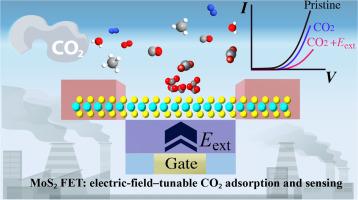Electric field effects on CO2 adsorption and electronic transport in MoS2: toward FET-based gas sensors
IF 6.3
2区 材料科学
Q2 CHEMISTRY, PHYSICAL
引用次数: 0
Abstract
Two-dimensional (2D) materials are promising candidates for gas sensing, but achieving selective CO₂ sensing remains challenging. Here, we combine density functional theory and nonequilibrium Green's function calculations to study how varying electric field strength modulates adsorption on the surface and quantum transport within monolayer MoS₂. Among the six gases investigated (CO, CO₂, CH₄, O₂, N₂, and H₂O), only CO₂ exhibits a transition from physisorption to chemisorption under the applied field, resulting in stronger binding. In contrast, N₂ and O₂ desorb, enabling selective CO₂ adsorption. At higher CO₂ coverages, the electric field enhances adsorption stability but cannot completely prevent saturation. We further explore CO₂ detection using MoS₂ FETs under gate-induced fields. The current sensitivity rises from 1.7 % for one adsorbed molecule to 64.3 % for five, while recovery time decreases. These results clarify the role of electric fields in tuning surface adsorption and charge transport in 2D semiconductors, supporting the design of FET-based gas sensors

电场对二硫化钼中CO2吸附和电子输运的影响:面向fet基气体传感器
二维(2D)材料是气体传感的有希望的候选者,但实现选择性CO₂传感仍然具有挑战性。本文将密度泛函理论和非平衡格林函数计算相结合,研究了电场强度变化如何调节表面吸附和单层MoS 2内的量子输运。在所研究的6种气体(CO、CO₂、CH₄、O₂、N₂和H₂O)中,只有CO₂在电场作用下由物理吸附转变为化学吸附,结合更强。相反,N₂和O₂解吸,使CO₂选择性吸附。在较高的CO₂覆盖率下,电场增强了吸附稳定性,但不能完全防止饱和。我们进一步探索了在栅极感应场下使用MoS 2 fet检测CO₂。电流灵敏度从1个吸附分子的1.7%上升到5个吸附分子的64.3%,而恢复时间缩短。这些结果阐明了电场在调节二维半导体表面吸附和电荷输运中的作用,为基于fet的气体传感器的设计提供了支持
本文章由计算机程序翻译,如有差异,请以英文原文为准。
求助全文
约1分钟内获得全文
求助全文
来源期刊

Surfaces and Interfaces
Chemistry-General Chemistry
CiteScore
8.50
自引率
6.50%
发文量
753
审稿时长
35 days
期刊介绍:
The aim of the journal is to provide a respectful outlet for ''sound science'' papers in all research areas on surfaces and interfaces. We define sound science papers as papers that describe new and well-executed research, but that do not necessarily provide brand new insights or are merely a description of research results.
Surfaces and Interfaces publishes research papers in all fields of surface science which may not always find the right home on first submission to our Elsevier sister journals (Applied Surface, Surface and Coatings Technology, Thin Solid Films)
 求助内容:
求助内容: 应助结果提醒方式:
应助结果提醒方式:


